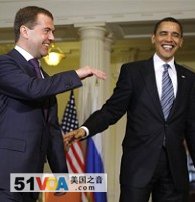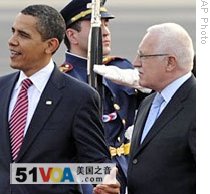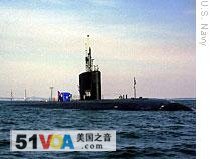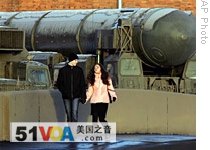Washington
08 April 2009
 |
| US President Barack Obama and Russian President Dmitri Medvedev during their meeting ahead of G20 summit in London, 01 Apr 2009 |
The decision to pursue talks replacing the START-1 treaty was reached during a London meeting earlier this month (April 3) between President Barack Obama and his Russian counterpart, Dmitri Medvedev - the first face-to-face meeting between the two leaders.
A few days later during a speech in Prague April 5, Mr. Obama said his administration will take concrete steps toward a world without nuclear weapons.
 |
| US Pres. Barack Obama walks with Czech Pres. Vaclav Klaus (R) past honor guard after arriving in Prague, 04 Apr 2009 |
The START-1 treaty was negotiated in the 1980s, signed by U.S. President George Herbert Walker Bush and Soviet President Mikhail Gorbachev in 1991, and came into force in 1994.
More than 1,000 pages long, START-1 is one of the most complex treaties in history, dealing with reducing nuclear weapons. Steve Andreasen, is a former arms control expert on the National Security Council, now teaching at the University of Minnesota.
 |
| Starboard bow view of the Los Angeles class nuclear-powered fast attack submarine USS Hartford (SSN 768) anchored off the U.S. Naval Academy |
The START treaty also established stringent and very intrusive verification procedures. Frank Miller, who also served as an arms control expert on the National Security Council [now with the independent consulting firm The Cohen Group], describes some of those measures.
"The key verification measures require teams to inspect and ensure that the missiles that each side deploys don't carry more than the warheads that they are supposed to be carrying. It continues to confirm that some U.S. bombers, all the B-1 bombers, no longer have a nuclear weapons role," he said. "We continue to monitor production of Russian mobile missiles to ensure that in their production of the SS-27 mobile ICBM [intercontinental ballistic missile], they are not also building, covertly, a missile called the SS-20 which was banned during the Reagan years [by the Intermediate-range Nuclear Forces treaty or INF]. So there are a large number of measures which allow the governments to be confident that the other side is in fact carrying out the [provisions of] the treaty," Miller added.
 |
| A couple passes by Russian ICBM Topol, reported by NATO as SS-25 Sickle, in St. Petersburg, Russia |
For the past several years, Russian and American officials have been trying to agree on a post-START-1 arrangement - but with little progress.
Experts say there is a new impetus now to reach agreement because of the Obama-Medvedev meeting. They say negotiators for both sides will try to decide on an even lower number of nuclear weapons and verification provisions to be included in the new treaty.
But will they agree by the December deadline? Once again, Frank Miller.
"If the presidents of both countries are issuing instructions to their negotiators not to let small things get in the way, and if the presidents keep watching over what their negotiators do, the answer is clearly 'yes'," he said.
Steve Andreasen also believes an agreement can be reached by December.
"Having said that, one of the tricks here is to try and get something done in time for the legislative process - that is the United States Senate and the Duma [parliament] in Russia - to approve whatever they do before the START-1 treaty expires in December," he said. "[Republican] Senator [Richard] Lugar, who is on the Foreign Relations Committee in the Senate in the United States, has said in order for that to happen, the new agreement needs to be done by August. So that's a very tight timeline," he noted.
Presidents Obama and Medvedev have instructed their arms negotiators to provide a progress report by July when the American leader is expected to visit Moscow for a summit meeting.